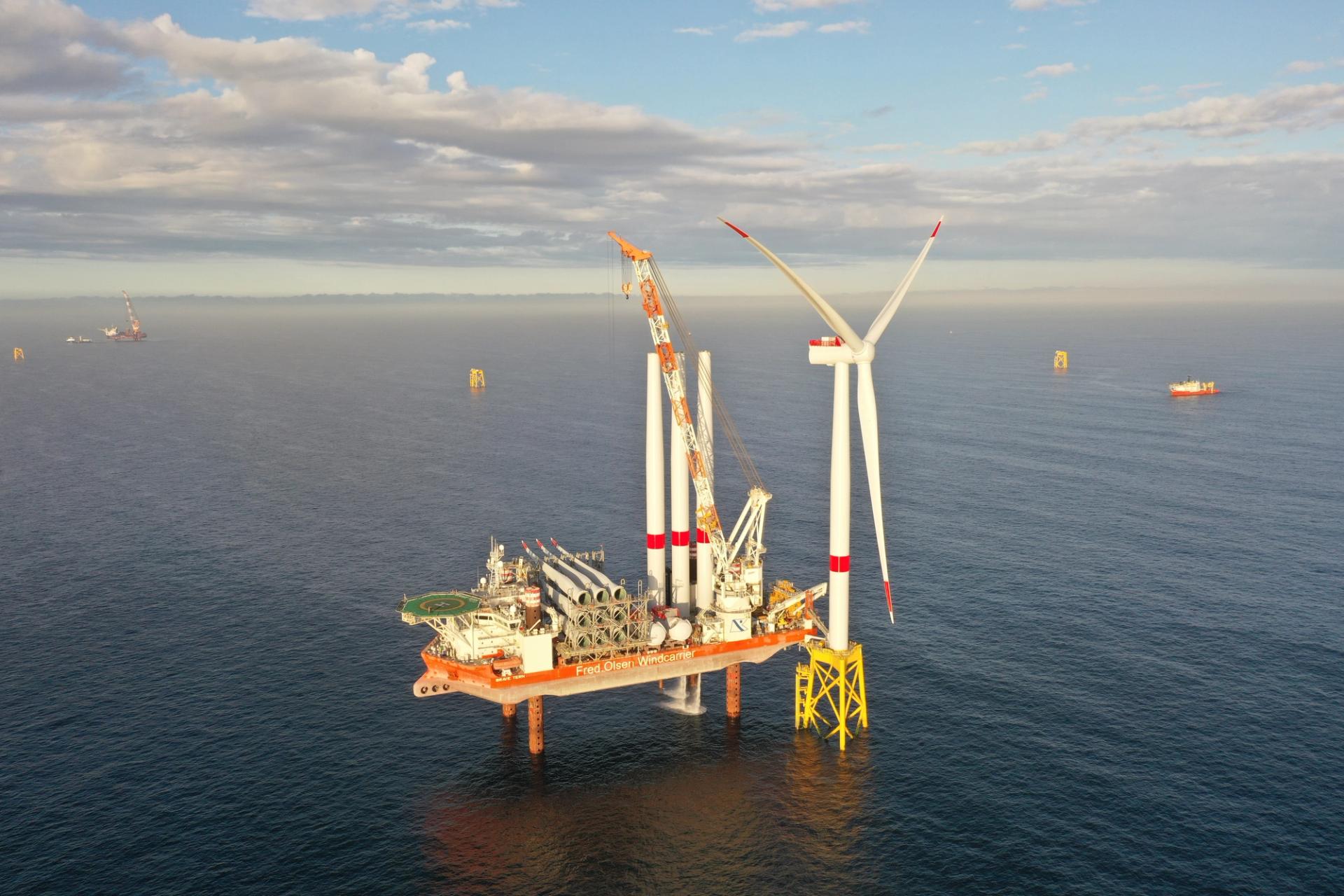Discover how offshore wind turbines are installed

Simply put, offshore wind turbines are large structures installed at sea to harness wind energy and generate electricity. These turbines are similar to their onshore counterparts but are designed to withstand the harsh marine environment.
Offshore wind turbines consist of a tower, rotor blades, and a nacelle containing the generator. They are often installed in clusters, called wind farms or wind parks, to maximise energy production.
Turbines are being scaled up both in physical size and in power capacity, significantly enhancing the performance and cost-efficiency of offshore wind farms.
Classifying offshore wind turbines
Offshore wind turbines vary in type and are classified according to a variety of factors. For example, they can be classified by their rotating axis as either vertical-axis or horizontal-axis turbines. They can also be classified by their power transmission, as either direct-drive or gearbox turbines.
Importantly, they are divided into two main foundation types: bottom-fixed and floating. Each has its own unique features – and installation methods.
Bottom-fixed offshore wind turbines – the most common
Bottom-fixed foundations are the most commonly used today. These turbines are anchored and fixed to the seabed and consist of four main types: gravity-based, monopile, tripod, and jacket. Bottom-fixed foundations can only be installed in areas with suitable water depths and seabed conditions and are generally installed in waters less than 60 m deep.
The investment in foundations accounts for as much as 20 to 30 per cent of the cost of a typical bottom-fixed offshore wind farm, so choosing the right foundation is key.
Floating wind turbines – harnessing wind power further out at sea
Installation of floating wind turbines is less reliant on seabed conditions, allowing operators to harvest wind resources in deeper waters, where they are most plentiful.
Floating turbines are moored to the seabed with mooring lines and anchors to stay in place. There is tremendous innovation in floating foundations, and current designs include semi-submersible platforms, spar, and tension legs.
The foundations represent the single largest investment when building a floating offshore wind farm, so again, choosing the right foundation is key.
How are offshore wind turbines installed?
Setting up offshore wind turbines is a complex task with strict safety and assembly standards. The process involves putting together the massive components of the turbine and securing it to the foundation before connecting it to the grid. All of this happens at sea, so it’s a large-scale marine operation with challenges due to logistics and harsh conditions offshore.
The installation process usually involves the following five steps:
1. Site preparation
Site preparation for offshore wind turbine installations includes seabed surveys to obtain data on seabed conditions and environmental impact assessments to evaluate the potential effects of the project on marine ecosystems, wildlife and local communities. Temporary facilities such as staging areas are set up to support operations.
2. Foundation installation
The installation process naturally reflects the differences between floating and bottom-fixed foundations and the seabed conditions.
Finding the right installation method
Numerical modelling is a cost-effective way to test and verify installation methods for offshore wind turbines. The technique is used to simulate real-world processes, provide analyses and predict the behaviour of systems without the need for physical testing. These tools are crucial for identifying potential risks during the planning phase, thereby enhancing the safety of the operation during execution.
Offshore wind turbine installation vessels
Installing offshore wind turbines requires specialised vessels, including wind turbine installation vessels (WTIV), or jack-up vessels, construction service operation vessels (CSOV) and feeder barges. Pioneering work is being done in designing hybrid offshore wind vessels that use alternative fuels such as hydrogen and methanol.
Process varies according to type of foundation
Bottom-fixed foundations are lowered onto the seabed using cranes or other lifting equipment. For monopile foundations, hydraulic hammers are used to drive the piles into the seabed. Gravity-based structures are lowered using ballast or water flooding to increase their weight and secure them in place. Meanwhile, jacket foundations, which are the most used, are installed using heavy-lift vessels equipped with cranes to position the jackets on the seabed.
Floating offshore wind turbines can be stabilised during operation ballast, buoyancy, or mooring, and most use a combination of these methods. As the design of floating wind turbines differs widely, custom installation methods are often needed.
3. Turbine installation
Regardless of whether the foundation is bottom-fixed or floating, once the tower is in place, the turbine blades and the nacelle, which contains the generator and other key components, lifted onto the top and bolted to the foundation.
How are offshore wind turbine blades installed?
There are multiple ways to install the rotor blades of offshore wind turbines. Research, development and testing are ongoing to find the most cost-efficient and safest methods. Single-blade installation is currently widely used. Instead of lifting all the blades at once, each blade is lifted separately, with about five to six lifts needed for the whole turbine.
However, with both this and other methods, rough seas can make it tricky to attach the blades, as the foundation may move dramatically. Specialised installation equipment such as shock absorbers and passive heave compensators can protect the crane, the lifted blade and the personnel during lifting operations.
4. Cable installation
Once the turbines have been installed, specialised cable-laying vessels bury cables in the seabed. These cables transmit power from the base of the tower to the substation, or transformer, then to the grid and on to the consumer.
5. Commissioning
Before a wind farm is commissioned and comes online, a set of mechanical, electrical, safety and performance tests are performed on the wind turbines, foundations and electrical system to ensure that they are operating correctly.
